2019 KIA K900 engine
[x] Cancel search: enginePage 45 of 580
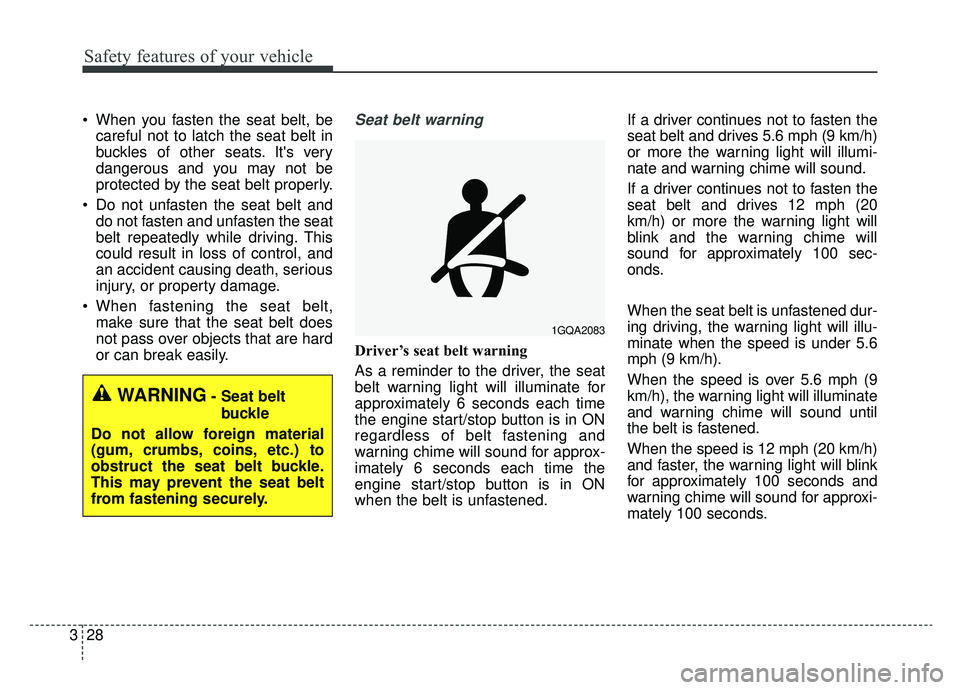
Safety features of your vehicle
28
3
When you fasten the seat belt, be
careful not to latch the seat belt in
buckles of other seats. It's very
dangerous and you may not be
protected by the seat belt properly.
Do not unfasten the seat belt and do not fasten and unfasten the seat
belt repeatedly while driving. This
could result in loss of control, and
an accident causing death, serious
injury, or property damage.
When fastening the seat belt, make sure that the seat belt does
not pass over objects that are hard
or can break easily.Seat belt warning
Driver’s seat belt warning
As a reminder to the driver, the seat
belt warning light will illuminate for
approximately 6 seconds each time
the engine start/stop button is in ON
regardless of belt fastening and
warning chime will sound for approx-
imately 6 seconds each time the
engine start/stop button is in ON
when the belt is unfastened. If a driver continues not to fasten the
seat belt and drives 5.6 mph (9 km/h)
or more the warning light will illumi-
nate and warning chime will sound.
If a driver continues not to fasten the
seat belt and drives 12 mph (20
km/h) or more the warning light will
blink and the warning chime will
sound for approximately 100 sec-
onds.
When the seat belt is unfastened dur-
ing driving, the warning light will illu-
minate when the speed is under 5.6
mph (9 km/h).
When the speed is over 5.6 mph (9
km/h), the warning light will illuminate
and warning chime will sound until
the belt is fastened.
When the speed is 12 mph (20 km/h)
and faster, the warning light will blink
for approximately 100 seconds and
warning chime will sound for approxi-
mately 100 seconds.
WARNING- Seat belt
buckle
Do not allow foreign material
(gum, crumbs, coins, etc.) to
obstruct the seat belt buckle.
This may prevent the seat belt
from fastening securely.
1GQA2083
Page 46 of 580
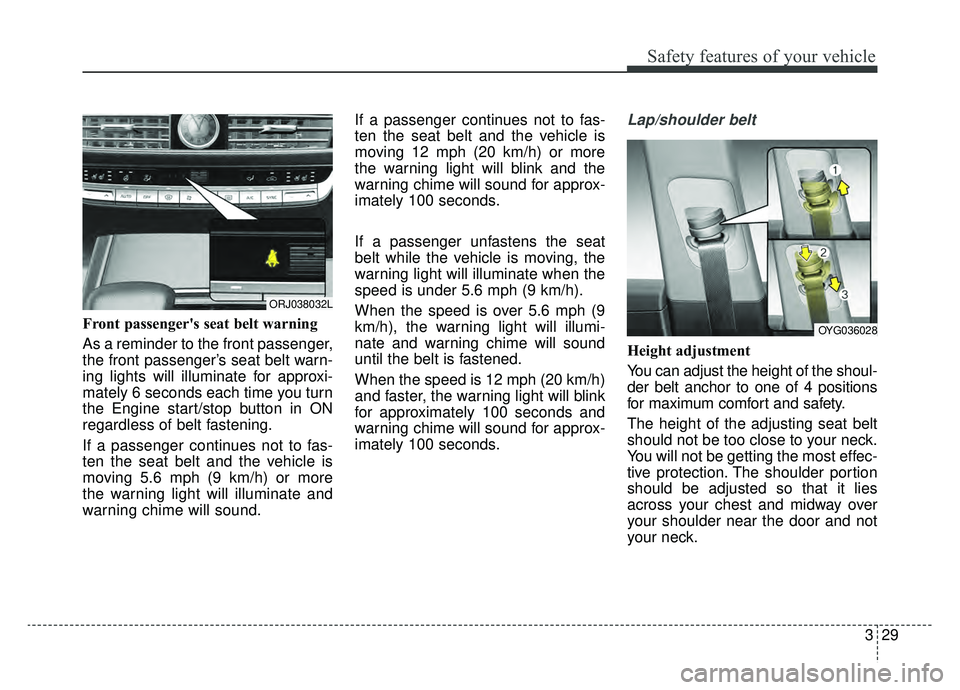
329
Safety features of your vehicle
Front passenger's seat belt warning
As a reminder to the front passenger,
the front passenger’s seat belt warn-
ing lights will illuminate for approxi-
mately 6 seconds each time you turn
the Engine start/stop button in ON
regardless of belt fastening.
If a passenger continues not to fas-
ten the seat belt and the vehicle is
moving 5.6 mph (9 km/h) or more
the warning light will illuminate and
warning chime will sound.If a passenger continues not to fas-
ten the seat belt and the vehicle is
moving 12 mph (20 km/h) or more
the warning light will blink and the
warning chime will sound for approx-
imately 100 seconds.
If a passenger unfastens the seat
belt while the vehicle is moving, the
warning light will illuminate when the
speed is under 5.6 mph (9 km/h).
When the speed is over 5.6 mph (9
km/h), the warning light will illumi-
nate and warning chime will sound
until the belt is fastened.
When the speed is 12 mph (20 km/h)
and faster, the warning light will blink
for approximately 100 seconds and
warning chime will sound for approx-
imately 100 seconds.
Lap/shoulder belt
Height adjustment
You can adjust the height of the shoul-
der belt anchor to one of 4 positions
for maximum comfort and safety.
The height of the adjusting seat belt
should not be too close to your neck.
You will not be getting the most effec-
tive protection. The shoulder portion
should be adjusted so that it lies
across your chest and midway over
your shoulder near the door and not
your neck.
OYG036028
ORJ038032L
Page 51 of 580
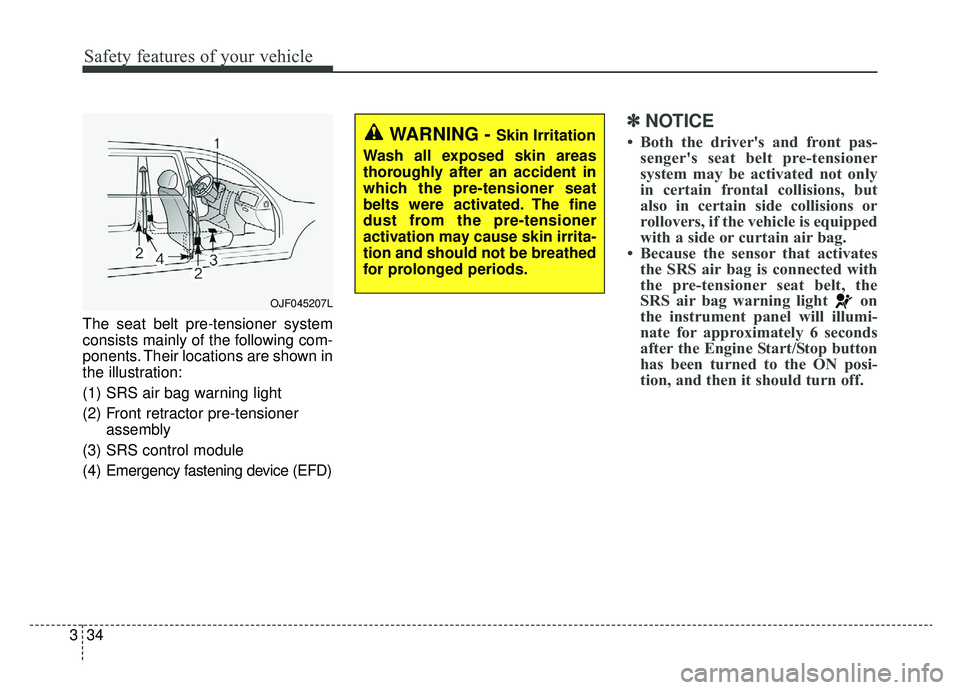
Safety features of your vehicle
34
3
The seat belt pre-tensioner system
consists mainly of the following com-
ponents. Their locations are shown in
the illustration:
(1) SRS air bag warning light
(2) Front retractor pre-tensioner
assembly
(3) SRS control module
(4) Emergency fastening device (EFD)
✽ ✽ NOTICE
• Both the driver's and front pas-
senger's seat belt pre-tensioner
system may be activated not only
in certain frontal collisions, but
also in certain side collisions or
rollovers, if the vehicle is equipped
with a side or curtain air bag.
• Because the sensor that activates the SRS air bag is connected with
the pre-tensioner seat belt, the
SRS air bag warning light on
the instrument panel will illumi-
nate for approximately 6 seconds
after the Engine Start/Stop button
has been turned to the ON posi-
tion, and then it should turn off.
OJF045207L
WARNING - Skin Irritation
Wash all exposed skin areas
thoroughly after an accident in
which the pre-tensioner seat
belts were activated. The fine
dust from the pre-tensioner
activation may cause skin irrita-
tion and should not be breathed
for prolonged periods.
Page 52 of 580
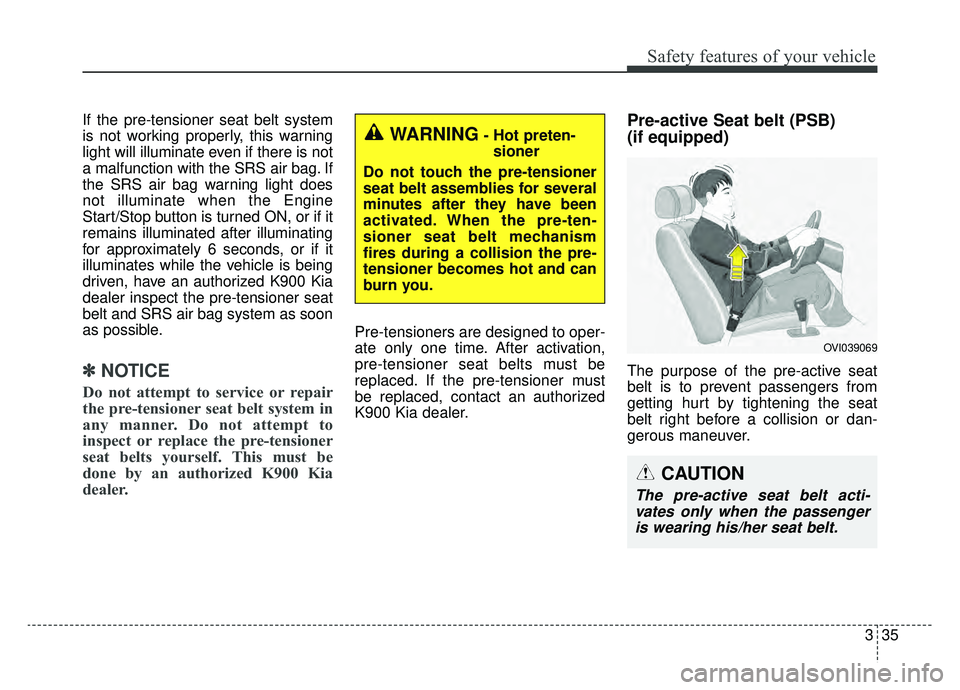
335
Safety features of your vehicle
If the pre-tensioner seat belt system
is not working properly, this warning
light will illuminate even if there is not
a malfunction with the SRS air bag. If
the SRS air bag warning light does
not illuminate when the Engine
Start/Stop button is turned ON, or if it
remains illuminated after illuminating
for approximately 6 seconds, or if it
illuminates while the vehicle is being
driven, have an authorized K900 Kia
dealer inspect the pre-tensioner seat
belt and SRS air bag system as soon
as possible.
✽ ✽NOTICE
Do not attempt to service or repair
the pre-tensioner seat belt system in
any manner. Do not attempt to
inspect or replace the pre-tensioner
seat belts yourself. This must be
done by an authorized K900 Kia
dealer.
Pre-tensioners are designed to oper-
ate only one time. After activation,
pre-tensioner seat belts must be
replaced. If the pre-tensioner must
be replaced, contact an authorized
K900 Kia dealer.
Pre-active Seat belt (PSB)
(if equipped)
The purpose of the pre-active seat
belt is to prevent passengers from
getting hurt by tightening the seat
belt right before a collision or dan-
gerous maneuver.
WARNING- Hot preten-
sioner
Do not touch the pre-tensioner
seat belt assemblies for several
minutes after they have been
activated. When the pre-ten-
sioner seat belt mechanism
fires during a collision the pre-
tensioner becomes hot and can
burn you.
OVI039069
CAUTION
The pre-active seat belt acti- vates only when the passengeris wearing his/her seat belt.
Page 68 of 580
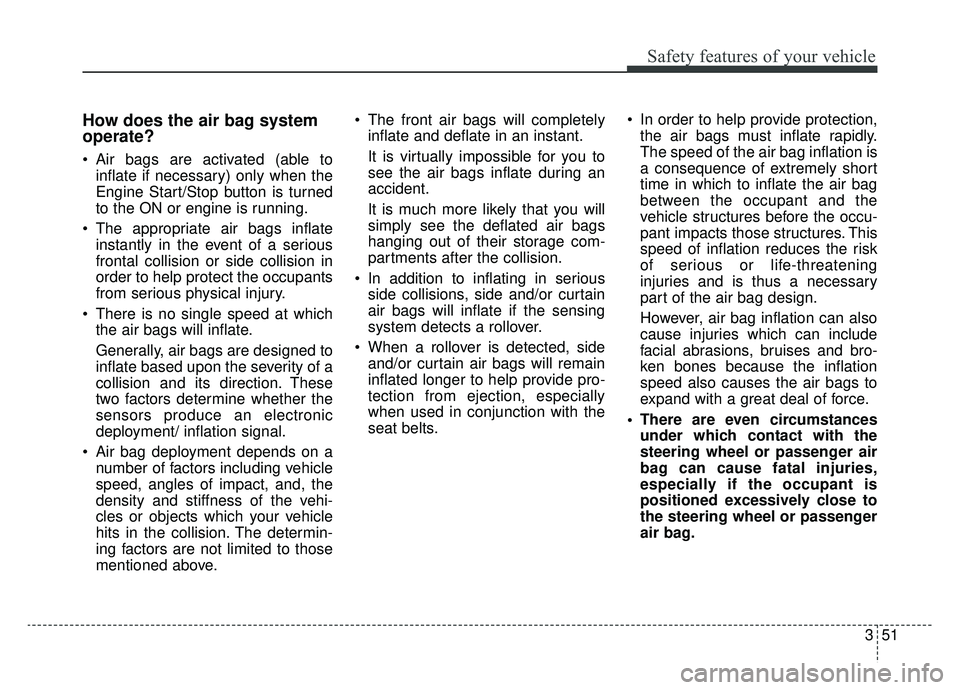
351
Safety features of your vehicle
How does the air bag system
operate?
Air bags are activated (able toinflate if necessary) only when the
Engine Start/Stop button is turned
to the ON or engine is running.
The appropriate air bags inflate instantly in the event of a serious
frontal collision or side collision in
order to help protect the occupants
from serious physical injury.
There is no single speed at which the air bags will inflate.
Generally, air bags are designed to
inflate based upon the severity of a
collision and its direction. These
two factors determine whether the
sensors produce an electronic
deployment/ inflation signal.
Air bag deployment depends on a number of factors including vehicle
speed, angles of impact, and, the
density and stiffness of the vehi-
cles or objects which your vehicle
hits in the collision. The determin-
ing factors are not limited to those
mentioned above. The front air bags will completely
inflate and deflate in an instant.
It is virtually impossible for you to
see the air bags inflate during an
accident.
It is much more likely that you will
simply see the deflated air bags
hanging out of their storage com-
partments after the collision.
In addition to inflating in serious side collisions, side and/or curtain
air bags will inflate if the sensing
system detects a rollover.
When a rollover is detected, side and/or curtain air bags will remain
inflated longer to help provide pro-
tection from ejection, especially
when used in conjunction with the
seat belts. In order to help provide protection,
the air bags must inflate rapidly.
The speed of the air bag inflation is
a consequence of extremely short
time in which to inflate the air bag
between the occupant and the
vehicle structures before the occu-
pant impacts those structures. This
speed of inflation reduces the risk
of serious or life-threatening
injuries and is thus a necessary
part of the air bag design.
However, air bag inflation can also
cause injuries which can include
facial abrasions, bruises and bro-
ken bones because the inflation
speed also causes the air bags to
expand with a great deal of force.
There are even circumstances under which contact with the
steering wheel or passenger air
bag can cause fatal injuries,
especially if the occupant is
positioned excessively close to
the steering wheel or passenger
air bag.
Page 71 of 580

Safety features of your vehicle
54
3
SRS components and functions
The SRS consists of the following
components:
1. Driver's front air bag module
2. Passenger's front air bag module
3. Side air bag modules
4. Curtain air bag modules
5. Retractor pre-tensioner assemblies
6. Air bag warning light
7. SRS control module (SRSCM) /
Rollover sensor
8. Front impact sensors 9. Side impact sensors
10. PASSENGER AIR BAG “OFF”
indicator (Front passenger’s seat
only)
11. Occupant detection system (Front passenger’s seat only)
12. Emergency fastening device (EFD)
13. Driver`s knee air bag module
If the air bag warning light is illumi-
nated for more than 6 seconds after
the Engine Start/Stop button is
turned on, or of it illuminates during
vehicle operation, an SRS compo-
nent may not be functioning properly
and you should have your vehicle
checked by an authorized K900 Kia
dealer.
W7-147
ORJ038078N
Page 72 of 580
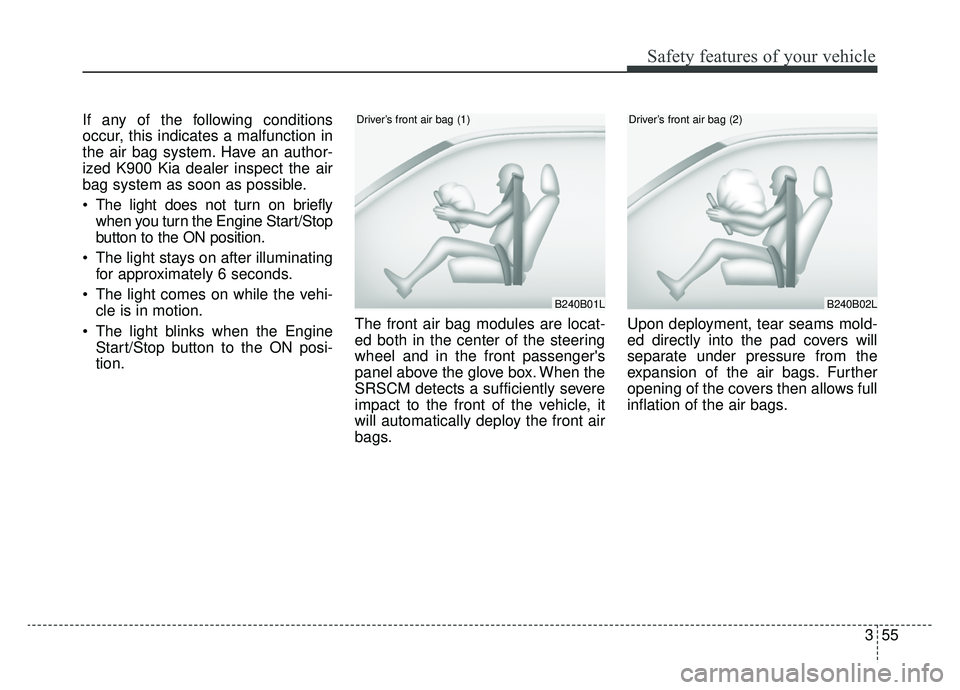
355
Safety features of your vehicle
If any of the following conditions
occur, this indicates a malfunction in
the air bag system. Have an author-
ized K900 Kia dealer inspect the air
bag system as soon as possible.
The light does not turn on brieflywhen you turn the Engine Start/Stop
button to the ON position.
The light stays on after illuminating for approximately 6 seconds.
The light comes on while the vehi- cle is in motion.
The light blinks when the Engine Start/Stop button to the ON posi-
tion. The front air bag modules are locat-
ed both in the center of the steering
wheel and in the front passenger's
panel above the glove box. When the
SRSCM detects a sufficiently severe
impact to the front of the vehicle, it
will automatically deploy the front air
bags. Upon deployment, tear seams mold-
ed directly into the pad covers will
separate under pressure from the
expansion of the air bags. Further
opening of the covers then allows full
inflation of the air bags.
B240B01L
Driver’s front air bag (1)
B240B02L
Driver’s front air bag (2)
Page 74 of 580

357
Safety features of your vehicle
The SRS can function only whenthe Engine Start/Stop button is in
the ON position. If the SRS air bag
warning light does not illuminate,
or continuously remains on after
illuminating for about 6 seconds
when the ignition switch is turned
to the ON position, or after the
engine is started, comes on while
driving, the SRS is not working
properly. If this occurs, have your
vehicle immediately inspected by
an authorized K900 Kia dealer.
✽ ✽ NOTICE
Before you replace a fuse or discon-
nect a battery terminal, turn the
Engine Start/Stop button to the OFF
position.
Never remove or replace the air bag
related fuse (s) when the Engine
Start/Stop button to the ON position.
Failure to heed this warning will
cause the SRS air bag warning light
to illuminate.
Occupant Detection System
(ODS)
Your vehicle is equipped with an
occupant detection system in the
front passenger's seat.
The occupant detection system is
designed to detect the presence of a
properly-seated front passenger and
determine if the passenger's front air
bag should be enabled (may inflate)
or not. Only the front passenger front
air bag is controlled by the Occupant
Detection System.
Do not put anything in front of the
PASSENGER AIR BAG OFF indica-
tor.
Main components of the occu-
pant detection system
An detection device located within the front passenger seat cushion.
An electronic system which deter- mines whether the passenger air
bag systems should be activated
or deactivated.
An indicator light located on the instrument panel which illuminates
the words PASSENGER AIR BAG
“OFF” indicates the front passen-
ger air bag system is deactivated.
The instrument panel air bag warn- ing light is interconnected with the
occupant detection system.
ORJ038046N